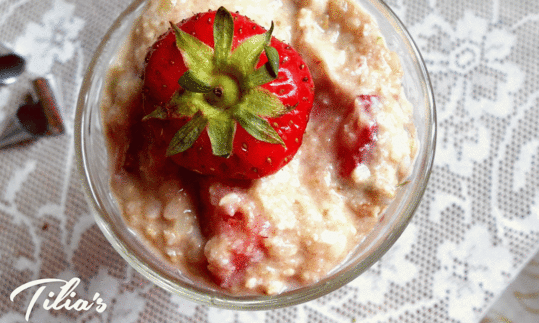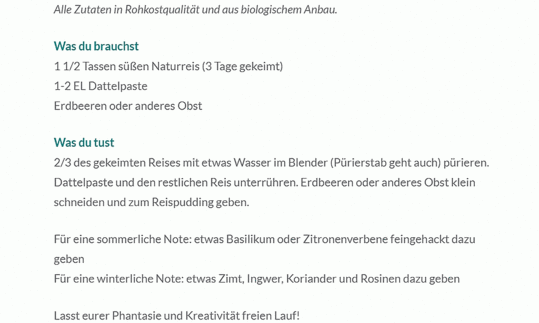Raw rice pudding made from sprouted brown rice with strawber
raw-vegan
Ingredients (for servings, )
| 3 ½ oz | Sweet brown rice (mochi rice, raw, organic?) |
| 3 | Dates, Medjool variety, pitted, raw? (organic?) (2.5 oz) |
| 4 | Strawberries (organic?) (2.1 oz) |
Equipment
- food processor or hand-held blender / immersion blender
- sprouter (sprouting jar)
Type of preparation
- sprouted
- chop or grind
- food preparation without heating
- purée
Preparation
Preparation
Let the sweet brown rice germinate for 3 days (see tips). It is best to use a germination jar for this.The original recipe recommends 1.5 cups of sprouted brown rice (approx. 250 g) for 2 servings. This corresponds to approximately 100 g of unsprouted rice.
preparation
Put ⅔ of the sprouted rice into a food processor with a little water and the dates to puree (a hand blender will also work). Then stir in the remaining rice.The original recipe calls for 1-2 tablespoons of date paste for 2 portions. Instead, we simply used 3 Medjol dates. You can also use a different type of date. However, the Medjol date is characterized by its sweetness and soft consistency and is therefore particularly suitable.
Serve
Cut strawberries or other fruit into small pieces and add to the rice pudding.
|
Nutritional Information per person
Convert per 100g
|
2000 kcal | |
|---|---|---|
| Energy | 284 kcal | 14.2% |
| Fat/Lipids | 0.69 g | 1.0% |
| Saturated Fats | 0.16 g | 0.8% |
| Carbohydrates (inc.dietary fiber) | 69 g | 25.4% |
| Sugars | 25 g | 28.3% |
| Fiber | 3.9 g | 15.6% |
| Protein/Albumin | 4.6 g | 9.1% |
| Cooking Salt (Na:5.7 mg) | 14 mg | 0.6% |
| Essential micronutrients with the highest proportions | per person | 2000 kcal | |
|---|---|---|---|
| Min | Manganese, Mn | 1.2 mg | 61.0% |
| Min | Copper, Cu | 0.24 mg | 25.0% |
| Vit | Vitamin C (ascorbic acid) | 18 mg | 22.0% |
| Vit | Vitamin B6 (pyridoxine) | 0.30 mg | 22.0% |
| Min | Selenium, Se | 12 µg | 21.0% |
| Elem | Phosphorus, P | 130 mg | 19.0% |
| Elem | Potassium, K | 371 mg | 19.0% |
| Prot | Threonine (Thr, T) | 0.17 g | 18.0% |
| Elem | Magnesium, Mg | 63 mg | 17.0% |
| Prot | Tryptophan (Trp, W) | 0.04 g | 17.0% |
Detailed Nutritional Information per Person for this Recipe
The majority of the nutritional information comes from the USDA (US Department of Agriculture). This means that the information for natural products is often incomplete or only given within broader categories, whereas in most cases products made from these have more complete information displayed.
If we take flaxseed, for example, the important essential amino acid ALA (omega-3) is only included in an overarching category whereas for flaxseed oil ALA is listed specifically. In time, we will be able to change this, but it will require a lot of work. An “i” appears behind ingredients that have been adjusted and an explanation appears when you hover over this symbol.
For Erb Muesli, the original calculations resulted in 48 % of the daily requirement of ALA — but with the correction, we see that the muesli actually covers >100 % of the necessary recommendation for the omega-3 fatty acid ALA. Our goal is to eventually be able to compare the nutritional value of our recipes with those that are used in conventional western lifestyles.
| Essential fatty acids | per person | 2000 kcal |
|---|---|---|
| Linoleic acid; LA; 18:2 omega-6 | 0.22 g | 2.0% |
| Alpha-Linolenic acid; ALA; 18:3 omega-3 | 0.02 g | 1.0% |
| Essential amino acids | per person | 2000 kcal |
|---|---|---|
| Threonine (Thr, T) | 0.17 g | 18.0% |
| Tryptophan (Trp, W) | 0.04 g | 17.0% |
| Valine (Val, V) | 0.28 g | 17.0% |
| Isoleucine (Ile, I) | 0.20 g | 16.0% |
| Leucine (Leu, L) | 0.36 g | 15.0% |
| Phenylalanine (Phe, F) | 0.21 g | 14.0% |
| Lysine (Lys, K) | 0.17 g | 9.0% |
| Methionine (Met, M) | 0.07 g | 8.0% |
| Vitamins | per person | 2000 kcal |
|---|---|---|
| Vitamin C (ascorbic acid) | 18 mg | 22.0% |
| Vitamin B6 (pyridoxine) | 0.30 mg | 22.0% |
| Pantothenic acid (vitamin B5) | 0.83 mg | 14.0% |
| Niacin (née vitamin B3) | 2.1 mg | 13.0% |
| Thiamine (vitamin B1) | 0.12 mg | 11.0% |
| Folate, as the active form of folic acid (née vitamin B9 and | 23 µg | 11.0% |
| Biotin (ex vitamin B7, H) | 3.0 µg | 6.0% |
| Vitamin K | 2.1 µg | 3.0% |
| Riboflavin (vitamin B2) | 0.03 mg | 2.0% |
| Vitamin E, as a-TEs | 0.09 mg | 1.0% |
| Vitamin A, as RAE | 2.8 µg | < 0.1% |
| Essential macroelements (macronutrients) | per person | 2000 kcal |
|---|---|---|
| Phosphorus, P | 130 mg | 19.0% |
| Potassium, K | 371 mg | 19.0% |
| Magnesium, Mg | 63 mg | 17.0% |
| Calcium, Ca | 33 mg | 4.0% |
| Sodium, Na | 5.7 mg | 1.0% |
| Essential trace elements (micronutrients) | per person | 2000 kcal |
|---|---|---|
| Manganese, Mn | 1.2 mg | 61.0% |
| Copper, Cu | 0.24 mg | 25.0% |
| Selenium, Se | 12 µg | 21.0% |
| Zinc, Zn | 0.70 mg | 7.0% |
| Iron, Fe | 0.85 mg | 6.0% |
| Iod, I (Jod, J) | 2.3 µg | 2.0% |
| Fluorine, F | 1.3 µg | < 0.1% |
The raw rice pudding made from sprouted brown rice with strawberries and date paste is a nice and healthy alternative to traditional rice pudding.
Time required: The high time required is due to the soaking and germination time of the rice. However, this can easily be done in advance (with appropriate planning).
Nutrient profile: Since there are no more precise ingredient details for sweet brown rice, the nutrient profile only shows the basic nutritional values (first table) correctly. For normal whole grain rice, which is very similar in composition, one portion of this recipe covers more than the average daily requirement of manganese according to GDA guidelines. It also meets over 20% of the average daily requirement of vitamin C, vitamin B6, vitamin B1, vitamin B3, potassium, copper, phosphorus and magnesium.
Wholegrain rice: Wholegrain rice is the rice fruit consisting of the endosperm, germ and surrounding silver skin that remains after the husks have been removed. Since a large proportion of the vitamins are stored in the outer shell, the proportion of vitamins, trace elements, protein and fiber is higher than in normal rice products. Sweet rice, also called mochi rice, originally comes from Japan. It is particularly suitable for desserts. Its taste is not really sweet, as the name suggests, but rather tasteless.
Dates: The date fruit with its honey-like sweet taste is actually a berry fruit. It is rich in vitamin B6 and the minerals copper and potassium. It also contains more fiber than conventional wholemeal bread.
Strawberries: Strawberries have a high vitamin C content. Unlike apples and kiwis, strawberries do not ripen if picked too early (non-climacteric fruit). Therefore, you should pay attention to the color and scent when buying.
Germinate rice: Whole grain rice can be easily germinated and then eaten raw. Leave the rice in water for 12 hours (use about 3 times the amount of water). Then pour the water through a sieve. There is no germination visible yet, but the process has begun. Do not submerge the rice again, but leave it moist and rinse it in the sieve again in the morning and evening and lay it out again. Rice germinates in light, so it needs a bright place to germinate (but not direct sunlight). Place the sprouting jar tilted on top of it or in the drainer.
After two to three days you should be able to clearly see the sprouting. 100 g of rice will give you about 250 g of sprouted rice. The rice can now be eaten raw and has a slightly nutty taste.





